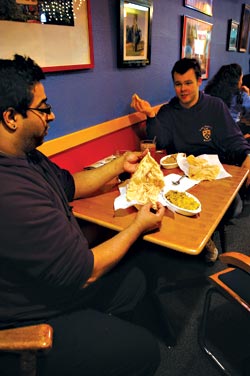Thank goodness the people who tried to ruin the burrito by inventing the wrap never discovered the roti. A soft, platter-sized flatbread wrapped around curried vegetables and meats, the roti is as iconic in Trinidad and Tobago as the cheese steak is in Philadelphia. If the dish sounds Indian, that’s because its origins are. About 40 percent of Trinidad and Tobago’s population is descended from South Asians, who began emigrating during the 1830s. Trinidadian food is a glorious mix of African, Asian, and European influences, which come through in dishes with poetic names like crab and callaloo, phulori, and shark and bake. Though griddled flatbreads called roti are eaten throughout India, in Trinidad roti (made with a larger bread and fillings) have evolved into a distinctive street food. These can be found in sublime form at Pam’s Kitchen, Seattle’s newest—heck, only—Trinidadian restaurant.
Pam Jacobs and her husband, Patrick Churaman, used to own a cafe in Trinidad, and Pam says she has been dreaming of opening her own restaurant since the family moved to Seattle 12 years ago. When Pam’s son discovered this spot on the corner of 50th Street and the Ave in the U District, the family used their savings to take it over several months ago. Now everyone—husband, kids, nephews, and nieces—takes turns staffing the place.
Though it’s no Michael Graves design showpiece, their restaurant is awash in color and spice. The owners didn’t shy away from painting their walls a blue the color of the bottom of the sea, nor pairing that blue with an orange the color of a fuyu persimmon, accented with mango- hued gold. Their food, the aroma of which swaddles you the moment you enter, is perfumed with peppers and ginger, cinnamon and garlic. Like the colors, the flavors don’t clash; they amplify one another.
The house-made beverages, like sorrel (a sweet-tart, allspice-spiked hibiscus drink) or one of the frothy milk shakes (the peanut punch rocks), are worth a try, though I’d caution first-timers against the mauby, a sugary drink that’s also bitter because of the tree bark with which it’s made. Diners can choose one of two wrappers for their roti, which the cooks roll out the moment the order comes in. The first type, the paratha, is a thick, buttery, white-flour round, also called “buss-up-shut” because the crumpled bread looks like a “busted-up shirt.” The second kind of wrap, dhalpuri, has a very fine layer of ground split peas in the center. The effect of both butter and legumes is to make the bread tender and flaky.
The vegetarian roti contains just the base, a soft, creamy curry of potatoes and chickpeas. It’s certainly pleasant. But when you add one of the meats, which have been cooked in a different spice blend, and then dribble on some of the yellow habanero-vinegar sauce (stored in little pots on the front counter), curry meets curry and spice layers upon spice in a great explosion of ginger, turmeric, cumin, coriander, and meat. Its intensity depends on the meat. The chicken was all right (it’s breast meat, which dries out when braised), the goat was better, but the lamb and beef attained meltdown levels of goodness.
Jacobs recently brought cooks from Trinidad to help her in the kitchen, and she’s planning to fill out the menu with more Creole (African-influenced) fare. For now, she’s introducing Creole dishes through the specials board. On my last visit, the specials included callaloo—taro leaves simmered in coconut milk, whose mucilaginous texture could be off-putting if the taste weren’t so rich. A big salmon steak simmered in a tomato-pepper sauce was pleasant but lacked the vibrancy of the curries. Jerk chicken, however, was baroque in its complexity: With heat turned down for Seattle palates, the spices and herbs fused in the dark-brown lacquer on the meat.
Though dishes do come promptly, the relaxed island spirit prevails. At the end of one meal, feeling as soft and plump as the roti we’d just devoured, my guest and I craned our necks, wanting to ask for our check. Patrick Churaman caught my glance and walked over. “Take all the time you want,” he pre-empted, reassuring me with a pat on the arm. “You’re certainly welcome here.” Amused and chastened, we looked at each other. Then we settled back into our chairs.






